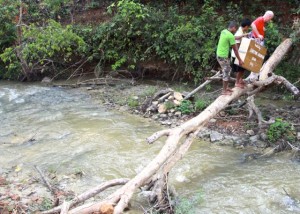Project Sekong 2014: When a sturdier footbridge is needed villagers employ unique skills!

Log footbridges are common since they require only effort to build. If the monsoon rains cause the stream to flood the villagers may lose a log but no other resources.
There’s more that should be said about bridges here. Most of this country’s ten thousand villages either sit beside or straddle a stream and there is always a compelling reason for people, hunters, farmers, foragers, to make their way to the other side. And, since the vast majority of villagers walk from place to place it follows that footbridges prevail.
Villagers feel there is little sense investing much effort into bridge construction because during the rainy season, whatever labor or resources have been invested could wash away. But if a sturdy, more permanent span is required villagers are capable of putting one up.
Or, more likely, chopping one down. An axman will find a large tree in a suitable location on the near bank and fell it, skillfully directing the tree so it lands with its upper branches on the far bank. Then, after a bit of touching up, villagers will soon be strolling the tree’s length.

When a village needs a more permanent footbridge the community will pool resources and construct a suspension bridge. Hanging high above the stream these remarkable structures will survive floods common to the monsoon season.
Most commonly, a suspension bridge is secured to large trees on opposing banks, and consists primarily of two or more steel cables spanning the river. Villagers lay boards over the taut cables and use vines, ropes, wires, tree branches and lengths of bamboo to weave a basket-like enclosure the full length of the structure. About all one can say about the weaving technique is that the villagers keep at until it looks more like bridge than anything else.
These bridges test courage and defeat confidence. In use they rock from side to side and bounce riotously up and down but, a pedestrian could hardly escape the basketry, much less fall out. Admittedly, a cable could break or an anchoring tree could uproot, but I’ve never personally seen one of these fall into the river below—with the singular exception of a collapsed span up in Phongsali Province. And, it only fell when a drunk driver tried to drive his car across.
Such is my reputation that the guys on the team will walk in threes across these bridges, carefree, but when I cross with them, they wait on the near bank until I successfully alight on the other side. I’ve even seen the guys cross on the heels of villagers pushing motorbikes or carrying backbreaking loads of firewood. But…nobody has the guts to stand in the middle of the span with me!
